
|
Great comet. It approached to Sun down to 0.29 a.u. on July 3, and it brightened up to 0.6 mag (Alan Hale). Now it is fading. But it is still very bright as 6.4 mag (Aug. 10, Marco Goiato). It stays observable in the evening sky until early October when it fades down to 12 mag.
Date(TT) R.A. (2000) Decl. Delta r Elong. m1 Best Time(A, h)
Aug. 15 13 46.18 8 13.6 1.173 1.115 60 7.4 18:54 (130, 33)
Aug. 22 14 4.99 2 34.3 1.394 1.250 60 8.3 18:58 (123, 34)
|
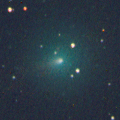
|
Now it is 10.3 mag (Aug. 8, Marco Goiato). It will brighten up to 8-9 mag from summer to autumn. It will be observable in excellent condition in the Southern Hemisphere. It locates very low in the Northern Hemisphere.
Date(TT) R.A. (2000) Decl. Delta r Elong. m1 Best Time(A, h)
Aug. 15 14 17.21 -15 46.7 1.309 1.432 74 9.6 18:54 (114, 55)
Aug. 22 14 35.39 -17 34.7 1.322 1.409 72 9.4 18:58 (109, 53)
|

|
Now it is 10.3 mag (Aug. 8, Marco Goiato). It stays observable in the evening sky until September when it fades down to 12 mag.
Date(TT) R.A. (2000) Decl. Delta r Elong. m1 Best Time(A, h)
Aug. 15 13 48.15 11 35.1 2.404 2.102 60 10.4 18:54 (133, 30)
Aug. 22 13 58.36 8 3.2 2.527 2.160 57 10.6 18:58 (125, 29)
|
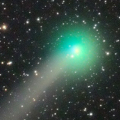
|
It brightened up to 6.0 mag in June (June 13, Marco Goiato). Now it is fading. It has already faded down to 10.5 mag (Aug. 8, Marco Goiato). It stays observable in good condition for a long time after this.
Date(TT) R.A. (2000) Decl. Delta r Elong. m1 Best Time(A, h)
Aug. 15 14 18.73 20 37.2 1.374 1.345 66 11.0 18:54 (146, 26)
Aug. 22 14 41.33 21 34.3 1.492 1.430 66 11.7 18:58 (144, 24)
|
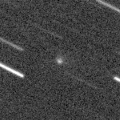
|
Now it is 15.5 mag (July 22, Martin Masek). Small comet. But it will approach to Sun down to 0.47 a.u. in September, and it is expected to brighten up to 11 mag. It stays observable in good condition until late August while the comet will be brightening up to 11 mag.
Date(TT) R.A. (2000) Decl. Delta r Elong. m1 Best Time(A, h)
Aug. 15 5 37.42 26 3.5 0.598 0.856 57 12.2 5:15 (219, 17)
Aug. 22 6 54.36 18 34.4 0.634 0.735 46 11.7 5:07 (234, 14)
|

|
Now it is 10.9 mag (Aug. 8, Marco Goiato). In the Southern Hemisphere, it stays observable in good condition in the evening sky while the comet will be fading. It locates very low in the Northern Hemisphere.
Date(TT) R.A. (2000) Decl. Delta r Elong. m1 Best Time(A, h)
Aug. 15 14 12.50 -28 24.2 0.734 1.127 78 12.4 18:54 ( 93, 61)
Aug. 22 15 3.62 -30 40.3 0.837 1.234 83 13.3 18:58 ( 92, 65)
|
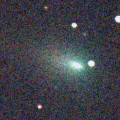
|
Recovered from SWAN images after 24-year blank. It brightened up to 10.2 mag in spring (May 31, Marco Goiato). Now it is fading. But it is still bright as 12.5 mag (July 27, Paul Camilleri). It stays observable for a long time after this until the comet fades out.
Date(TT) R.A. (2000) Decl. Delta r Elong. m1 Best Time(A, h)
Aug. 15 5 42.44 12 43.2 1.969 1.659 57 13.3 5:15 (229, 27)
Aug. 22 5 58.24 12 18.0 1.963 1.703 60 13.6 5:07 (228, 28)
|

|
Outburst occured on July 27. Now it is bright as 13.1 mag (July 31, Martin Masek).
Date(TT) R.A. (2000) Decl. Delta r Elong. m1 Best Time(A, h)
Aug. 15 2 51.42 26 28.7 5.659 5.818 94 13.5 5:15 (181, 28)
Aug. 22 2 52.62 26 45.8 5.553 5.819 100 13.5 4:51 (180, 28)
|

|
Now it is 13.5 mag (July 31, Ken-ichi Kadota). It is expected to brighten up to 12 mag from autumn to winter. In the Northern Hemisphere, it stays observable in good condition while the comet will be brightening gradually, but it is hardly observable at the high light. In the Southern Hemisphere, it is not observable for a long time, but it will be observable in good condition after the high light.
Date(TT) R.A. (2000) Decl. Delta r Elong. m1 Best Time(A, h)
Aug. 15 12 18.71 32 45.9 2.869 2.205 40 13.7 18:54 (131, 0)
Aug. 22 12 24.05 29 13.4 2.875 2.151 36 13.6 18:58 (125, -1)
|
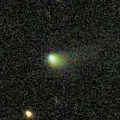
|
Now it is 14.2 mag (July 16, Paul Camilleri). It stays 13-14 mag from 2020 to 2021. It will be unobservable in September.
Date(TT) R.A. (2000) Decl. Delta r Elong. m1 Best Time(A, h)
Aug. 15 13 19.75 2 20.4 3.494 3.042 55 14.4 18:54 (120, 32)
Aug. 22 13 27.63 1 2.9 3.556 3.030 51 14.4 18:58 (114, 29)
|

|
Now it is 13.9 mag (July 19, Ken-ichi Kadota). It stays 14 mag until autumn. In the Southern Hemisphere, it will never be observable again.
Date(TT) R.A. (2000) Decl. Delta r Elong. m1 Best Time(A, h)
Aug. 15 12 23.41 80 47.1 4.338 4.088 69 14.4 18:54 (170,-30)
Aug. 22 12 54.29 78 48.8 4.363 4.129 70 14.5 18:58 (169,-29)
|

|
It was expected to brighten very rapidly, and brighten up to 14.5 mag from August to September. However, its current brightness is very uncertain. It could not be detected as fainter than 18.0 mag on June 30 (Charles S. Morris), and fainter than 15.7 mag on July 13 (Sandor Szabo). However, Giuseppe Pappa reported as 14 mag on July 10, and Thomas Lehmann reported it is bright as 15.2 mag on July 12. In the Northern Hemisphere, it stays observable for a long time, although it becomes extremely low in early September. In the Southern Hemisphere, it is not observable until late October.
Date(TT) R.A. (2000) Decl. Delta r Elong. m1 Best Time(A, h)
Aug. 15 10 34.71 54 34.8 1.450 0.972 41 14.7 18:54 (139,-27)
Aug. 22 10 38.79 48 18.7 1.529 0.947 37 14.7 18:58 (130,-29)
|
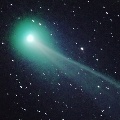
|
It brightened up to 4.7 mag in early May (May 2, Marco Goiato). However, it has faded and got diffused after that. It had already faded down to 7.3 mag in late May (May 21, Mitsunori Tsumura). It is appearing in the morning sky. However, maybe it has already disappeared. It stays observable in good condition after this.
Date(TT) R.A. (2000) Decl. Delta r Elong. m1 Best Time(A, h)
Aug. 15 6 44.61 17 36.5 2.319 1.706 41 14.8 5:15 (237, 13)
Aug. 22 6 46.18 15 44.3 2.326 1.818 48 15.1 5:07 (235, 18)
|
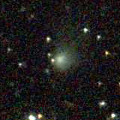
|
Now it is 15.5 mag (July 31, Charles S. Morris). It is expected to be observable at 5-6 mag for a long time from 2022 to 2023. In the Northern Hemisphere, it is not observable at the high light from 2022 summer to 2023 summer. In the Southern Hemisphere, it is only visible in the extremely low sky in summer in 2020. But it will be observable in good condition at the high light.
Date(TT) R.A. (2000) Decl. Delta r Elong. m1 Best Time(A, h)
Aug. 15 17 8.20 48 53.5 8.373 8.493 93 14.9 19:31 (180, 6)
Aug. 22 17 6.33 48 1.0 8.359 8.441 91 14.9 19:02 (180, 7)
|
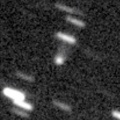
|
Now it is 15.4 mag (July 9, R. Carstens). It will brighten up to 13 mag in 2021. In the Northern Hemisphere, it will be unobservable soon. In the Southern Hemisphere, it stays observable at 15 mag until October.
Date(TT) R.A. (2000) Decl. Delta r Elong. m1 Best Time(A, h)
Aug. 15 13 55.90 -25 53.3 4.711 4.540 74 14.9 18:54 ( 95, 56)
Aug. 22 13 58.89 -26 33.9 4.774 4.504 68 14.9 18:58 ( 89, 50)
|
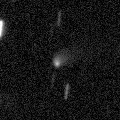
|
Now it is 15.1 mag (July 18, P. Camilleri, H. Williams, J. Oey, M. Al-Bussadi). It stays 14-15 mag until 2021. In the Southern Hemisphere, it stays observable in good condition for a long time. In the Northern Hemisphere, it is not observable until June in 2021.
Date(TT) R.A. (2000) Decl. Delta r Elong. m1 Best Time(A, h)
Aug. 15 15 20.63 -78 4.9 4.363 4.693 102 15.2 18:54 ( 5, 46)
Aug. 22 15 36.18 -77 14.1 4.390 4.671 99 15.2 18:58 ( 7, 47)
|

|
Now it is 15.5 mag (July 18, P. Camilleri, H. Williams, J. Oey, M. Al-Bussadi). It will brighten up to 13.5 mag in spring in 2021. In the Southern Hemisphere, it stays observable in good condition for a long time. In the Northern Hemisphere, it is not observable until spring in 2021.
Date(TT) R.A. (2000) Decl. Delta r Elong. m1 Best Time(A, h)
Aug. 15 18 43.22 -64 56.1 3.437 4.054 121 15.3 21:05 ( 0, 60)
Aug. 22 18 19.53 -63 36.2 3.484 4.019 115 15.3 20:15 ( 0, 62)
|
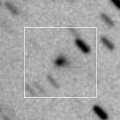
|
Now it is 14.7 mag (July 27, D. Buczynski). It will brighten up to 12 mag in winter in 2022. In the Northern Hemisphere, it stays observable in good condition for a long time. In the Southern Hemisphere, it is not observable until 2021 November.
Date(TT) R.A. (2000) Decl. Delta r Elong. m1 Best Time(A, h)
Aug. 15 0 56.02 62 9.8 5.521 5.693 94 15.5 3:22 (180, -7)
Aug. 22 0 54.75 63 0.8 5.413 5.649 98 15.4 2:54 (180, -8)
|
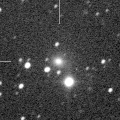
|
It brightened up to 13.5 mag in winter (Dec. 6, Chris Wyatt). Now it is fading slowly. Now it is 15.1 mag (July 25, ATLAS-MLO, Mauna Loa). In the Southern Hemisphere, it stays observable for a long time. In the Northern Hemisphere, it is appearing in the morning sky, but it stays low for a while.
Date(TT) R.A. (2000) Decl. Delta r Elong. m1 Best Time(A, h)
Aug. 15 3 21.59 -36 1.1 3.827 4.152 101 15.4 5:15 (280, 83)
Aug. 22 3 18.36 -36 26.6 3.789 4.187 106 15.5 5:07 (306, 88)
|

|
Now it is 15.6 mag (July 19, Thomas Lehmann). It stays 15-16 mag for a long time until 2021.
Date(TT) R.A. (2000) Decl. Delta r Elong. m1 Best Time(A, h)
Aug. 15 19 1.71 20 8.9 3.801 4.501 128 15.4 21:24 (180, 35)
Aug. 22 18 53.75 20 14.3 3.874 4.507 123 15.5 20:49 (180, 35)
|

|
Now it is 15.9 mag (Aug. 11, Toshihiko Ikemura, Hirohisa Sato). It is observable at 15-16 mag in good condition from June to August.
Date(TT) R.A. (2000) Decl. Delta r Elong. m1 Best Time(A, h)
Aug. 15 19 9.22 -5 54.3 1.165 2.062 142 15.5 21:32 (180, 61)
Aug. 22 19 11.03 -7 5.1 1.209 2.067 136 15.6 21:07 (180, 62)
|

|
Now it is 15.4 mag (July 29, Martin Masek). It stays 15.5 mag from summer to winter, and observable in good condition. It locates somewhat low in the Southern Hemisphere.
Date(TT) R.A. (2000) Decl. Delta r Elong. m1 Best Time(A, h)
Aug. 15 6 8.80 19 27.3 2.318 1.845 50 15.6 5:15 (229, 18)
Aug. 22 6 25.28 19 30.4 2.291 1.869 53 15.6 5:07 (229, 18)
|

|
New comet. Now it is 15.5 mag (Aug. 4, M. Mattiazzo). Although it is a tiny comet, it will approach to Sun down to 0.34 a.u. on Oct. 20, and it is expected to brighten up to 8.5 mag. In the Southern Hemisphere, it stays observable in good condition until late September when it brightens up to 11.5 mag. In the Northern Hemisphere, it stays unobservable for a while. But it will appear in the morning sky at 10 mag in late October. Then it stasy observable while the comet will be fading rapidly.
Date(TT) R.A. (2000) Decl. Delta r Elong. m1 Best Time(A, h)
Aug. 15 12 28.04 -70 11.9 1.162 1.531 89 16.2 18:54 ( 24, 43)
Aug. 22 12 24.94 -66 42.6 1.118 1.408 82 15.7 18:58 ( 29, 40)
|

|
Now it is 15.6 mag (July 25, ATLAS-MLO, Mauna Loa). It is observable at 15-16 mag in 2020. It is observable in excellent condition in the Southern Hemisphere. It locates somewhat low in the Northern Hemisphere.
Date(TT) R.A. (2000) Decl. Delta r Elong. m1 Best Time(A, h)
Aug. 15 18 21.30 -27 27.5 6.089 6.812 132 15.8 20:44 (180, 82)
Aug. 22 18 16.18 -27 4.4 6.204 6.827 124 15.9 20:12 (180, 82)
|

|
Now it is 16.1 mag (Aug. 1, M. Jaeger, E. Prosperi, S. Prosperi, W. Vollmann). It will stay at 15 mag for a long time from 2021 to 2022. In the Northern Hemisphere, it stays observable in good condition while brightening gradually. In the Southern Hemisphere, it stays locating low for a long time.
Date(TT) R.A. (2000) Decl. Delta r Elong. m1 Best Time(A, h)
Aug. 15 17 40.12 26 19.3 5.611 6.023 109 16.0 20:03 (180, 29)
Aug. 22 17 36.34 24 57.0 5.652 5.994 104 16.0 19:32 (180, 30)
|

|
Now it is 17.0 mag (July 29, ATLAS-MLO, Mauna Loa). It will brighten up to 14 mag in November, and will be observable in excellent condition.
Date(TT) R.A. (2000) Decl. Delta r Elong. m1 Best Time(A, h)
Aug. 15 2 10.56 -35 40.6 0.921 1.640 115 16.5 4:36 ( 0, 89)
Aug. 22 2 30.64 -36 8.5 0.850 1.580 115 16.1 4:28 ( 0, 89)
|

|
Now it is 16.8 mag (July 2, R. Carstens). It brightens up to 16 mag from summer to winter. In the Southern Hemisphere, it is observable in excellent condition. In the Northern Hemisphere, it is not observable until late October.
Date(TT) R.A. (2000) Decl. Delta r Elong. m1 Best Time(A, h)
Aug. 15 21 49.95 -70 39.9 1.027 1.796 123 16.3 0:18 ( 0, 54)
Aug. 22 21 31.47 -70 41.8 0.999 1.748 120 16.2 23:26 ( 0, 54)
|
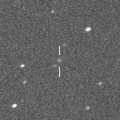
|
Now it is 16.4 mag (July 25, G. Hug). It will brighten up to 14.5 mag from spring to summer in 2021. In the Southern Hemisphere, it stays observable in excellent condition for a long time. In the Northern Hemisphere, it is observable in good condition in 2020, however, it will be unobservable in 2021.
Date(TT) R.A. (2000) Decl. Delta r Elong. m1 Best Time(A, h)
Aug. 15 22 47.99 -1 15.4 2.719 3.681 158 16.4 1:15 (180, 56)
Aug. 22 22 39.07 -3 41.8 2.638 3.634 168 16.3 0:38 (180, 58)
|
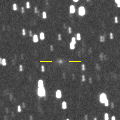
|
Now it is 16.5 mag (July 19, Thomas Lehmann). It will brighten up to 16.5 mag and will be observable in good condition from June to October.
Date(TT) R.A. (2000) Decl. Delta r Elong. m1 Best Time(A, h)
Aug. 15 20 15.49 15 45.4 1.250 2.152 143 16.3 22:38 (180, 39)
Aug. 22 20 13.33 14 35.9 1.260 2.148 141 16.3 22:08 (180, 40)
|
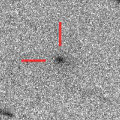
|
Now it is 16.4 mag (Aug. 2, ATLAS-HKO, Haleakala). It brightens up to 16 mag in September. It is observable in good condition in the Northern Hemisphere. It locates low in the Southern Hemisphere.
Date(TT) R.A. (2000) Decl. Delta r Elong. m1 Best Time(A, h)
Aug. 15 5 22.17 22 14.7 1.383 1.259 61 16.5 5:15 (218, 22)
Aug. 22 5 48.80 22 44.5 1.377 1.264 61 16.3 5:07 (219, 21)
|
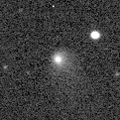
|
It brightened up to 13.8 mag in autumn in 2019 (Sept. 3, Chris Wyatt). Now it is fading slowly. Now it is 16.1 mag (July 28, Martin Masek). In 2020, it stays observable in good condition while the comet will be fading from 16 to 17 mag.
Date(TT) R.A. (2000) Decl. Delta r Elong. m1 Best Time(A, h)
Aug. 15 0 31.55 1 13.1 5.322 6.076 134 16.4 2:58 (180, 54)
Aug. 22 0 28.35 1 22.6 5.289 6.118 142 16.4 2:27 (180, 54)
|
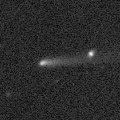
|
Now it is 15.7 mag (July 28, Martin Masek). It was expected to brighten rapidly up to 9.5 mag in June. But actually, it is fainter than predicted. However, it became very bright as 7.5 mag in SOHO spacecraft images on June 19 (Karl Battams). It is observable in good condition after this while the comet will be fading.
Date(TT) R.A. (2000) Decl. Delta r Elong. m1 Best Time(A, h)
Aug. 15 6 10.48 25 7.3 1.343 1.040 49 16.4 5:15 (226, 13)
Aug. 22 6 23.11 24 29.4 1.394 1.141 53 17.1 5:07 (225, 15)
|
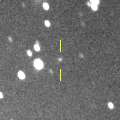
|
Now it is 15.9 mag (Apr. 24, J. Drummond). It is expected to brighten up to 13 mag in 2022. In 2020, it is observable in excellent condition in the Southern Hemisphere. In the Northern Hemisphere, it is not observable. It will be observable from autumn to winter, but it locating extremely low.
Date(TT) R.A. (2000) Decl. Delta r Elong. m1 Best Time(A, h)
Aug. 15 7 41.71 -26 48.6 7.363 6.754 49 16.6 5:15 (285, 28)
Aug. 22 7 47.12 -27 16.0 7.299 6.714 51 16.6 5:07 (283, 31)
|
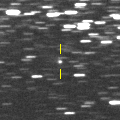
|
Now it is 16.8 mag (July 20, A. Diepvens). It will be observable at 16.5-17 mag from spring in 2020 to summer in 2021.
Date(TT) R.A. (2000) Decl. Delta r Elong. m1 Best Time(A, h)
Aug. 15 17 39.77 13 55.6 4.165 4.678 114 16.6 20:03 (180, 41)
Aug. 22 17 33.60 12 19.4 4.250 4.670 108 16.7 19:29 (180, 43)
|
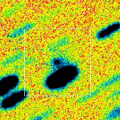
|
Now it is 16.4 mag (July 29, ATLAS-MLO, Mauna Loa). It brightens up to 15 mag in winter. But it is not observable at high light. In the Southern Hemisphere, it stays observable in good condition until autumn when the comet will brighten up to 16 mag. It stays locating very low in the Northern Hemisphere.
Date(TT) R.A. (2000) Decl. Delta r Elong. m1 Best Time(A, h)
Aug. 15 17 51.65 -40 34.5 1.801 2.514 124 16.8 20:15 ( 0, 85)
Aug. 22 17 52.48 -39 18.7 1.844 2.487 118 16.7 19:49 ( 0, 86)
|

|
It brightened up to 13.2 mag from spring to autumn in 2019 (June 30, Thomas Lehmann). Now it is fading slowly. It has already faded down to 16.6 mag (July 17, ATLAS-MLO, Mauna Loa). In the Southern Hemisphere, it stays observable for a long time. In the Northern Hemisphere, it stays low for a long time.
Date(TT) R.A. (2000) Decl. Delta r Elong. m1 Best Time(A, h)
Aug. 15 23 27.98 -31 3.5 3.602 4.506 149 16.8 1:55 (180, 86)
Aug. 22 23 19.29 -31 0.7 3.614 4.546 154 16.9 1:19 (180, 86)
|
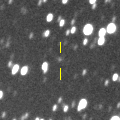
|
Now it is 16.2 mag (July 22, D. Buczynski). It will be observable at 16.5-17 mag from 2020 to 2021. In the Southern Hemisphere, it is not observable until summer in 2021.
Date(TT) R.A. (2000) Decl. Delta r Elong. m1 Best Time(A, h)
Aug. 15 1 15.60 74 16.3 6.107 6.110 85 16.9 3:43 (180,-19)
Aug. 22 0 58.70 74 36.7 6.023 6.099 89 16.8 2:58 (180,-20)
|
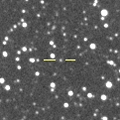
|
Now it is 16.9 mag (Aug. 11, Toshihiko Ikemura, Hirohisa Sato). It stays at 17 mag from 2020 to 2021.
Date(TT) R.A. (2000) Decl. Delta r Elong. m1 Best Time(A, h)
Aug. 15 19 11.36 32 12.0 8.323 8.899 121 17.1 21:34 (180, 23)
Aug. 22 19 7.94 32 6.3 8.359 8.894 119 17.1 21:03 (180, 23)
|

|
Now it is 17.9 mag (July 31, ATLAS-HKO, Haleakala). It is expected to brighten up to 16 mag from October to November, and it will be observable in excellent condition.
Date(TT) R.A. (2000) Decl. Delta r Elong. m1 Best Time(A, h)
Aug. 15 0 14.66 -36 22.3 0.809 1.706 138 17.5 2:41 ( 0, 89)
Aug. 22 0 16.11 -37 7.3 0.747 1.661 141 17.3 2:15 ( 0, 88)
|

|
First return of a new periodic comet which brightened up to 17.5 mag in 2012. Now it is 17.3 mag (July 23, ATLAS-MLO, Mauna Loa). It stays observable at 17 mag in good condition from summer to winter. It locates somewhat low in the Southern Hemisphere.
Date(TT) R.A. (2000) Decl. Delta r Elong. m1 Best Time(A, h)
Aug. 15 4 13.92 27 13.9 2.340 2.314 75 17.3 5:15 (201, 25)
Aug. 22 4 24.88 28 13.9 2.272 2.323 80 17.3 5:07 (198, 24)
|
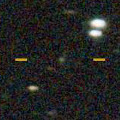
|
Now it is 17.1 mag (July 31, ATLAS-HKO, Haleakala). It became brighter than orignally predicted. It stays observable at 17 mag in good condition until autumn.
Date(TT) R.A. (2000) Decl. Delta r Elong. m1 Best Time(A, h)
Aug. 15 14 3.70 -17 36.4 2.166 2.099 72 17.3 18:54 (109, 53)
Aug. 22 14 16.64 -18 45.8 2.228 2.094 69 17.4 18:58 (103, 50)
|
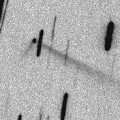
|
Main-belt asteroid. But it showed a straight tail like a comet in 2019. In 2020, it brightens up to 16.5 mag and stays observable in good condition from September to October.
Date(TT) R.A. (2000) Decl. Delta r Elong. m1 Best Time(A, h)
Aug. 15 0 41.64 12 2.1 1.411 2.183 127 17.5 3:08 (180, 43)
Aug. 22 0 40.91 10 50.6 1.363 2.199 135 17.3 2:40 (180, 44)
|

|
It brightened up to 7.7 mag in June in 2018 (June 19, Juan Jose Gonzalez). Now it is fading. It has already faded down to 16.9 mag (Apr. 22, J. Drummond). In the Southern Hemisphere, it stays observable for a long time until the comet will fade out. It will be observable in good condition after late August also in the Northern Hemisphere.
Date(TT) R.A. (2000) Decl. Delta r Elong. m1 Best Time(A, h)
Aug. 15 6 32.50 -10 17.8 7.957 7.380 52 17.4 5:15 (258, 34)
Aug. 22 6 34.62 -10 27.1 7.938 7.432 56 17.4 5:07 (255, 37)
|

|
Now it is 18.8 mag (July 18, Jost Jahn). It will brighten up to 17.5 mag in autumn. It is observable in excellent condition in the Southern Hemisphere. It locates very low in the Northern Hemisphere.
Date(TT) R.A. (2000) Decl. Delta r Elong. m1 Best Time(A, h)
Aug. 15 23 30.18 -27 51.2 2.225 3.147 150 17.6 1:57 (180, 83)
Aug. 22 23 27.66 -29 27.5 2.204 3.144 153 17.5 1:27 (180, 84)
|

|
Now it is 19.3 mag (July 27, Jost Jahn). It will brighten up to 17.5 mag in September. It is observable in excellent condition in the Southern Hemisphere. It locates somewhat low in the Northern Hemisphere.
Date(TT) R.A. (2000) Decl. Delta r Elong. m1 Best Time(A, h)
Aug. 15 23 20.17 -11 37.0 1.045 2.010 155 17.6 1:46 (180, 66)
Aug. 22 23 20.07 -13 52.4 1.016 2.002 161 17.5 1:19 (180, 69)
|

|
Now it is 16.8 mag (July 18, P. Camilleri, H. Williams, J. Oey, M. Al-Bussadi). It will brighten up to 15.5 mag in early 2021. In 2020, it stays observable at 17 mag until November in the Southern Hemisphere. In the Northern Hemisphere, it will be unobservable soon. Then it stays unobservable until 2021 June.
Date(TT) R.A. (2000) Decl. Delta r Elong. m1 Best Time(A, h)
Aug. 15 14 18.76 -28 42.2 2.785 2.793 79 17.7 18:54 ( 93, 62)
Aug. 22 14 25.98 -28 51.5 2.820 2.737 74 17.7 18:58 ( 89, 57)
|
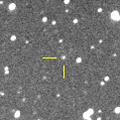
|
Now it is 17.8 mag (July 21, A. Diepvens). It was observed at 17 mag in 2019. In 2020, it is observable at 17.5 mag in good condition from summer to autumn.
Date(TT) R.A. (2000) Decl. Delta r Elong. m1 Best Time(A, h)
Aug. 15 1 2.95 -5 11.6 3.016 3.737 129 17.7 3:29 (180, 60)
Aug. 22 1 1.74 -5 27.8 2.951 3.744 135 17.7 3:00 (180, 60)
|
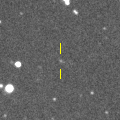
|
Now it is 17.3 mag (July 31, ATLAS-HKO, Haleakala). It stays 18 mag from 2019 to 2020.
Date(TT) R.A. (2000) Decl. Delta r Elong. m1 Best Time(A, h)
Aug. 15 21 1.38 -6 28.0 3.598 4.593 168 17.7 23:24 (180, 61)
Aug. 22 20 58.08 -6 55.0 3.619 4.595 162 17.7 22:53 (180, 62)
|
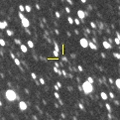
|
Sam Deen pointed out that it brightened in outburst twice in 2017 and 2019. It was observed at 20-21 mag in 2017. Then it became fainter than 22.9 mag in 2018 summer (Aug. 29, Sam Deen). However, it brightened up to 17.2 mag in 2019 spring (Mar. 25, B. T. Bolin). Then it faded again down to 19.9 mag (May 29, Toshihiko Ikemura, Hirohisa Sato). Now it is 18.1 mag (July 9, J. Jahn). It is predicted to stay observable at 18 mag for a long time from 2019 to 2021. But actually, it may be fainter than this ephemeris.
Date(TT) R.A. (2000) Decl. Delta r Elong. m1 Best Time(A, h)
Aug. 15 18 31.72 -24 35.3 6.983 7.731 134 17.7 20:55 (180, 80)
Aug. 22 18 29.36 -25 5.4 7.078 7.736 127 17.8 20:25 (180, 80)
|
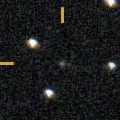
|
It is observable at 17-18 mag for a long time from late 2019 to early 2021. It will fade out before it passes the perihelion.
Date(TT) R.A. (2000) Decl. Delta r Elong. m1 Best Time(A, h)
Aug. 15 5 32.19 16 2.9 5.109 4.674 59 17.8 5:15 (224, 26)
Aug. 22 5 37.52 16 8.5 5.004 4.663 64 17.8 5:07 (221, 28)
|

|
Now it is 17.4 mag (July 26, J. Drummond). It will brighten up to 16.5 mag in 2021 summer. In the Southern Hemisphere, it stays observable for a while. In the Northern Hemisphere, it is not observable until 2021 February.
Date(TT) R.A. (2000) Decl. Delta r Elong. m1 Best Time(A, h)
Aug. 15 14 31.94 -49 37.7 5.585 5.680 90 17.8 18:54 ( 47, 64)
Aug. 22 14 36.66 -48 35.8 5.654 5.654 84 17.8 18:58 ( 52, 60)
|
|
![]()
 C/2020 F8 ( SWAN )
C/2020 F8 ( SWAN ) C/2017 K2 ( PanSTARRS )
C/2017 K2 ( PanSTARRS ) C/2019 F1 ( ATLAS-Africano )
C/2019 F1 ( ATLAS-Africano ) C/2020 F5 ( MASTER )
C/2020 F5 ( MASTER ) C/2020 J1 ( SONEAR )
C/2020 J1 ( SONEAR ) C/2019 L3 ( ATLAS )
C/2019 L3 ( ATLAS ) C/2018 F4 ( PanSTARRS )
C/2018 F4 ( PanSTARRS ) C/2019 K7 ( Smith )
C/2019 K7 ( Smith ) 115P/Maury
115P/Maury 84P/Giclas
84P/Giclas C/2020 P1 ( NEOWISE )
C/2020 P1 ( NEOWISE ) C/2017 U7 ( PanSTARRS )
C/2017 U7 ( PanSTARRS ) C/2018 U1 ( Lemmon )
C/2018 U1 ( Lemmon ) C/2020 M3 ( ATLAS )
C/2020 M3 ( ATLAS ) 162P/Siding Spring
162P/Siding Spring C/2019 T2 ( Lemmon )
C/2019 T2 ( Lemmon ) 257P/Catalina
257P/Catalina 304P/Ory
304P/Ory C/2017 B3 ( LINEAR )
C/2017 B3 ( LINEAR ) 249P/LINEAR
249P/LINEAR C/2019 T4 ( ATLAS )
C/2019 T4 ( ATLAS ) C/2017 Y2 ( PanSTARRS )
C/2017 Y2 ( PanSTARRS ) 17P/Holmes
17P/Holmes C/2018 A6 ( Gibbs )
C/2018 A6 ( Gibbs ) C/2019 T3 ( ATLAS )
C/2019 T3 ( ATLAS ) C/2019 O3 ( Palomar )
C/2019 O3 ( Palomar ) 156P/Russell-LINEAR
156P/Russell-LINEAR P/2020 M2 ( Lemmon )
P/2020 M2 ( Lemmon ) 278P/McNaught
278P/McNaught (6478) Gault
(6478) Gault C/2016 M1 ( PanSTARRS )
C/2016 M1 ( PanSTARRS ) 254P/McNaught
254P/McNaught 312P/NEAT
312P/NEAT 28P/Neujmin 1
28P/Neujmin 1 215P/NEAT
215P/NEAT P/2019 LD2 ( ATLAS )
P/2019 LD2 ( ATLAS ) C/2017 K5 ( PanSTARRS )
C/2017 K5 ( PanSTARRS ) 173P/Mueller 5
173P/Mueller 5 C/2020 O2 ( Amaral )
C/2020 O2 ( Amaral )![]()






































